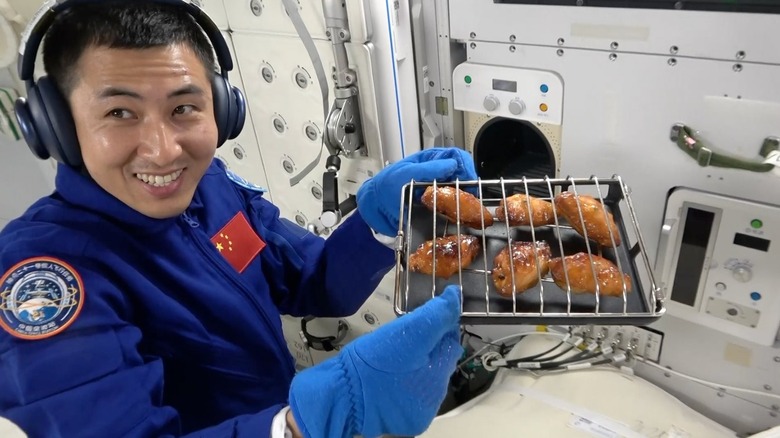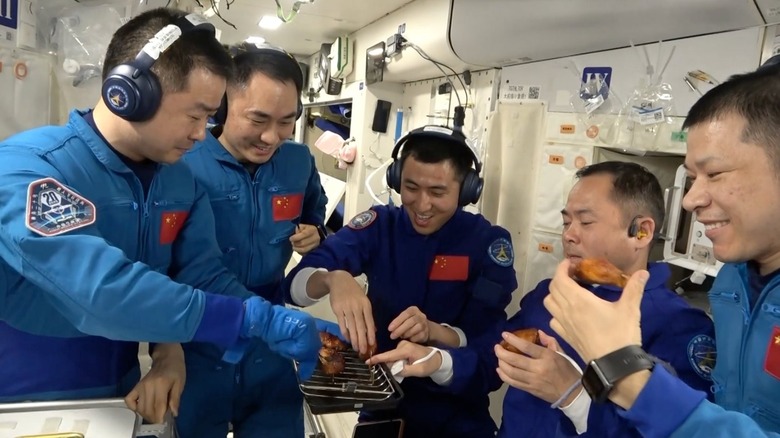China Installed A Zero-G Oven In The Tiangong Space Station - Here's Why It Matters
Chinese scientists have brought a tasty twist to spaceflight, as a newly installed zero-gravity oven will allow astronauts aboard the Tiangong space station to enjoy a host of culinary delights. Showcased in a viral video by the Astronaut Center of China, members of the Shenzhou 20 and Shenzhou 21 missions enjoyed chicken wings and black peppered steak in what the country believes will give its taikonauts a taste of home on long journeys through space. Cooking in space has traditionally been a difficult endeavor, as the lack of gravity made it nearly impossible for heat to rise the way it does in traditional convection ovens. Tiangong's oven, which resembles a miniature front-loaded laundry unit but functions like an air frier, comes equipped with a caged loading tray to prevent dinner from floating off before it can be devoured.
Global space agencies and private companies are attempting to build practical appliances and food solutions to accommodate the next stage of global space exploration. And while NASA first developed a zero-G oven for the International Space Station in 2020, the American version was much less powerful than its Chinese predecessor five years later. The jump results from advancements in high-temperature catalysis, temperature control, residue collection, and multi-layer filtration.
With these technological advancements, scientists can better accommodate the deluge of public and private sector space missions set to brave the stars in the next decade. China is set to become a global leader in space exploration, as it looks to become the first nation to put astronauts back on the moon. And with a gauntlet of budget cuts threatening the future of NASA-led space exploration, Beijing's dual-use space industry will take any advantage it can get in becoming the global leader in the next great space race.
Cooking in zero gravity
Historically, cooking in zero-G has faced several challenges. Due to a lack of gravity, hot air cannot rise, making traditional convection techniques functionally impossible. As such, it is difficult to reach the requisite temperatures for baking a cake or roasting a chicken. Before China's latest model, previous iterations could only reach 100 degrees Celsius, or 212 degrees Fahrenheit. The new model, by contrast, can hit 190 degrees Celsius, or 374 degrees Fahrenheit, vastly expanding its functionalities. China's oven also heats food more evenly, as the lack of gravity causes the hot air to stagnate and circulate unevenly in previous models.
NASA's model suffered from several of these issues. Built in collaboration with NanoRacks and Zero G Kitchen, the oven broke new culinary ground when it baked five chocolate chip cookies in 2020. An insulated, cylindrical container, the space oven was an electric-powered heating appliance analogous to a high-powered toaster. The greatest takeaway from the experiment was that baking in space is far more time-consuming than on Earth, taking over two hours to successfully bake a single cookie, roughly six times longer than Earth-bound recipes. As such, the experiment encapsulated many of the issues facing the next era of space chefs, with long cook times and limited functionality making cooking in space a largely impractical endeavor. China's model reportedly builds off these experiments. Integrated into the station, the new oven will be more than a temporary experiment, and is certified for 500 uses.
Finger lickin' good
While technical details are sparse, public statements to China's English-language paper, the Global Times, offer a glimpse at the Tiangong's new super oven. According to the Chinese Society of Astronautics' Kang Guohua, the space oven "was designed from the outset with full consideration of the space station's energy compatibility, uniform heat distribution, and safety. We built on prior experience and made extensive optimization." Technical advancements in temperature control and catalysis enabled the astronauts to roast their chicken wings in just 28 minutes. Because it is oil and grease-free, the oven is completely smokeless, helping the Tiangong meet the strict smoke emission standards necessary to preserve the station's delicate ecosystems. The oven reportedly won't be a toll on the ship's power grid, another major component of making zero-g cooking more viable for long-term missions.
While potential boosts in astronaut wellbeing are notable, the gravity of China's zero-g advancements is greater within the broader framework of the budding space race, where China seeks to become the chief steward of international space exploration. A September 2025 Commercial Space Federation report found that Beijing's capabilities will likely overtake Washington's over the next decade. China's investment in stations like the International Lunar Research Station, a Sino-Russo project with 17 nations and 50 research institutions, has Beijing primed to become a leader in space cooperation as the U.S. looks to deorbit the ISS. The implications are massive, as governments and companies alike turn towards space for everything from missile defense and satellite communications to renewable energy and rare material mining. A key factor in this race will be the ability to orchestrate sustained missions. With lifestyle advancements like zero-g ovens, China may make such missions easier than ever.


